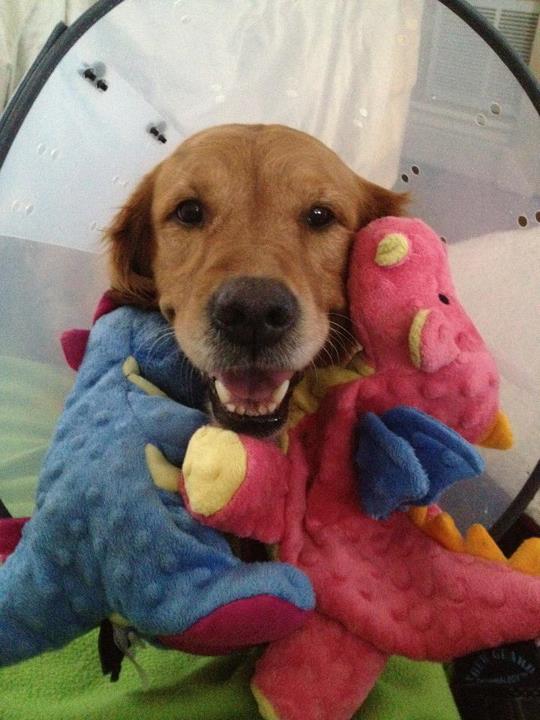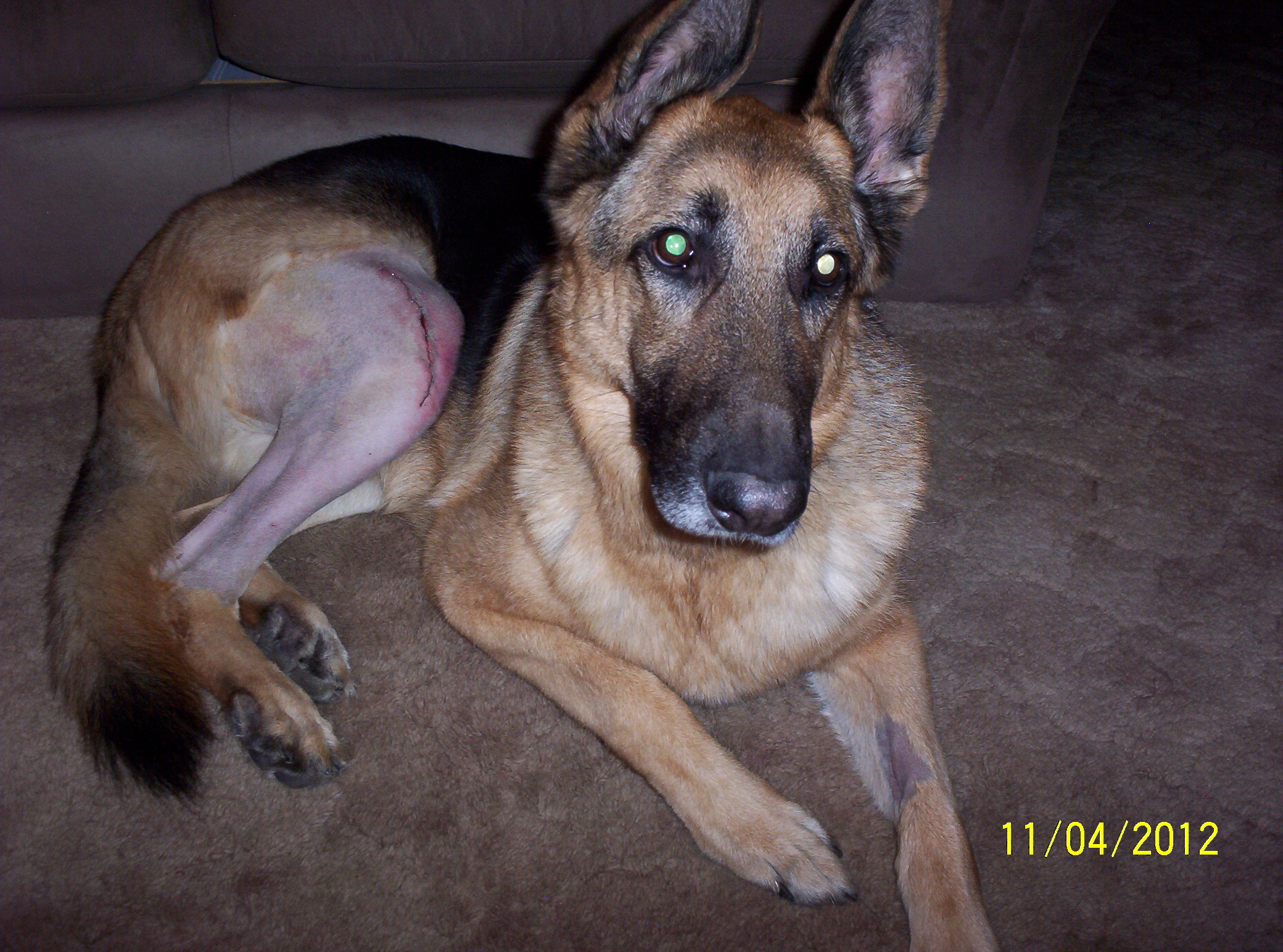
 About 3 years ago Forrest Gumbo, our approximately 3-year-old, healthy 45-pound pit bull that we adopted at 9 months old, the love of my life, was doing his usual figure 8 “zoomies” after one of our morning runs and he injured his right rear leg. He limped a little for a bit and always seemed to favor that leg, but he seemed “fine”, although he would hold his leg up every once in awhile, which was peculiar. We saw a vet who did a quick x-ray, said he probably had a small tear, gave us some Deramaxx, advised me to start him on a Glucosamine Chrondriotin supplement, walk less and life went on. I tried to accept this but was saddened that my little man was not 100% and may never be.
About 3 years ago Forrest Gumbo, our approximately 3-year-old, healthy 45-pound pit bull that we adopted at 9 months old, the love of my life, was doing his usual figure 8 “zoomies” after one of our morning runs and he injured his right rear leg. He limped a little for a bit and always seemed to favor that leg, but he seemed “fine”, although he would hold his leg up every once in awhile, which was peculiar. We saw a vet who did a quick x-ray, said he probably had a small tear, gave us some Deramaxx, advised me to start him on a Glucosamine Chrondriotin supplement, walk less and life went on. I tried to accept this but was saddened that my little man was not 100% and may never be.
After about a year and a half of shorter walks, a few pounds heavier, several different joint supplements, him seeming to become more aggravated in his behavior, not wanting to play much, not wanting to eat, getting him a new dog sister to play with, a trainer telling me “this dog is in severe pain”, and most importantly, holding that leg up often, I researched online and decided it was a cruciate tear. I took him to supposedly one of the best orthopedic vets who told me he had hip dysplasia, was 5 pounds overweight, possible arthritis and recommended long-term Rimadyl.
I didn’t want to accept this and so I asked for his x-rays and took them to a holistic vet we had seen a few months before and who we had started acupuncture with, plus she has really cool ideas that I agree with. The x-rays were so fuzzy she couldn’t read them and I found out that, after leaving him ALL day at the traditional vet for the x-rays, they had not sedated him in order to properly x-ray an extremely tense dog, and had not even looked at his knee.
On to the next young, modern traditional vet who did sedate him and much NOT to my surprise his hips were absolutely perfect. Since I didn’t explicitly ask to x-ray his knees, even though I told her that I suspected a cruciate tear, there were again no knee x-rays.
At this point I started thinking:
- I am speaking another language to the vets
- I am crazy
- Probably he just doesn’t like his rambunctious 2-year-old rescued American Bulldog sister
- Nothing is orthopedically wrong and he is just a weird rescue dog with “phantom pain” as she described to me.
Really? Just keep doing Rimadyl and joint supplements… he lost a few pounds from eating home-made food plus the very best dry kibble. I even went so far as to almost start him on a drug for nerves, thinking he might have nerve damage or a slipped disc in his back. My husband, all this time, insisting something is wrong with his groin area…
Well, I decided to take Forrest to a behaviorist veterinarian because he is obviously insane; after all, he is a rescued pit bull. She required all x-rays, medical records, etc. I stop by to pick up the x-rays and they had lost them! At this point I am losing all faith in traditional veterinarians, the vet I had originally saw was on maternity leave and unavailable, so we left the office with the older, experienced vet offering to once again sedate him and re-x-ray. Since it was only his hips and I saw very clearly that he did not have anything wrong with them I figured this was unnecessary for the behaviorist vet. Well, the next day I let him run really hard with another dog in our neighborhood because we so rarely see such joy in him anymore, and when I got home that night, he was dragging his back leg and could barely walk.
 I looked at this as a sign from above and figured the more experienced vet was who we were meant to see. I asked that while he is sedated let’s get this straight for the last time – x-ray everything! Guess what? He has a cruciate tear and needs surgery ASAP. What are my options? I work at an all natural pet supply store and I have talked (probably too much) to many people who’ve had the traditional repair as well as the TPLO done… what was best for my not small but not large dog?
I looked at this as a sign from above and figured the more experienced vet was who we were meant to see. I asked that while he is sedated let’s get this straight for the last time – x-ray everything! Guess what? He has a cruciate tear and needs surgery ASAP. What are my options? I work at an all natural pet supply store and I have talked (probably too much) to many people who’ve had the traditional repair as well as the TPLO done… what was best for my not small but not large dog?
I researched and saw that none of the surgeries are ever 100% so I chose the traditional repair where they use his own tissue to repair it. I like the sound of that – nothing foreign in his bod, and I was told “I’ve been doing this surgery for 30 years”. Sign us up, let’s get him better. Borrowed an extra large crate, got the cone of shame, and a few days later I am picking him up with a horrible tape cast on his leg (which is not used by many vets anymore so I am told and with good reason), some Tramadol, Rimadyl, no post-op instructions, and a “we’ll see you in 10 days to remove the bandage.” Probably needless to say, the tape ripped his fur and skin off to where it was raw and all he wanted to do was lick it. I used Vetericyn to ward off infection and tried to use the cone when I wasn’t there myself to stop him from licking… oh, and LOTS of bones to distract him. By the time we got to the 10-day mark the nasty tape cast was almost off.
 His sutures looked really good though and he was already using his leg so I thought he was well on his way to recovery… so why did everyone tell me that it took so much longer to recover? I was extremely careful not to let him run/jump, only walked him on his leash, allowing him to dictate the pace, even sent his nutty sister to doggy daycare so she wouldn’t pummel him, for about 6 weeks.
His sutures looked really good though and he was already using his leg so I thought he was well on his way to recovery… so why did everyone tell me that it took so much longer to recover? I was extremely careful not to let him run/jump, only walked him on his leash, allowing him to dictate the pace, even sent his nutty sister to doggy daycare so she wouldn’t pummel him, for about 6 weeks.
We tried to do range of motion exercises (recommended by the young vet) but he would get really tense and seemed like he was in pain; we bought an 8 foot pool to do hydrotherapy (recommended by the older vet) but he would just stand there in the water. In between I took him to be seen by the vet a few times and I was told he was “doing great” even though I felt like he was still limping too much and he was walking sideways. Did he re-injure it? Was it his left leg like I was told would probably be next due to overcompensating with that leg? Some days he seemed okay. Here we are today in July after a visit last week where I was told “there is nothing wrong with his knees” and they even charged me for an office visit.
I was beginning to think maybe I was one of “those people” when they finally told me to go see the orthopedic surgeon at a very well-known referral office; yes, the same one who most of my customers recommended but I was too worried about offending my vets. In fact, on the way to the vet today he was standing up and hanging out the window like old times. I was hoping I would be told I was crazy.
 Today, a week later, he was diagnosed with a possible miniscal tear, a very probable (post-operative?) luxating patella, and a torn cruciate ligament. Tomorrow he will be having TPLO surgery along with arthroscopic surgery. I do not know what the days ahead will be like (except for working overtime to pay for this 2nd surgery since my veterinary pet insurance money allotted for this surgery was spent on the first surgery and they do not cover “congenital” health items such as a luxating patella).
Today, a week later, he was diagnosed with a possible miniscal tear, a very probable (post-operative?) luxating patella, and a torn cruciate ligament. Tomorrow he will be having TPLO surgery along with arthroscopic surgery. I do not know what the days ahead will be like (except for working overtime to pay for this 2nd surgery since my veterinary pet insurance money allotted for this surgery was spent on the first surgery and they do not cover “congenital” health items such as a luxating patella).
I am worried about infection with the plate inserted in his skinny little legs, I’ve been warned that his left leg cruciate is also torn but I knew that, and we had already started ligament herbs and cold laser treatment with the holistic vet; I’m praying we can salvage that leg with CM, but I am also hopeful that I will once again see my sweet Forrest’s smile as he heals!
Conservative Management, Traditional Repair and TPLO – Forrest Gumbo’s Story is a post from: Dog Knee Surgery and Ligament Injuries












































